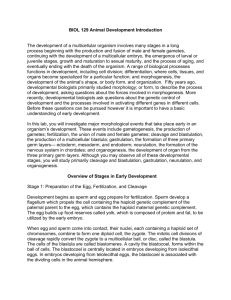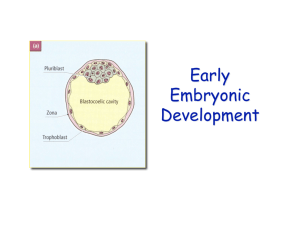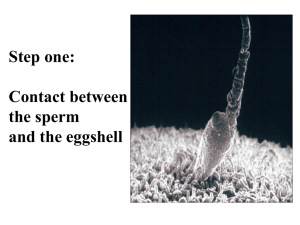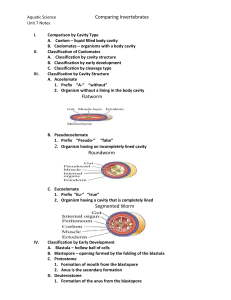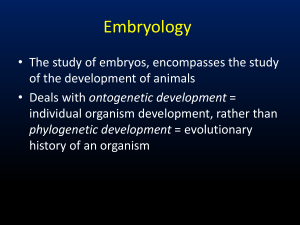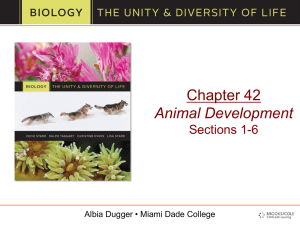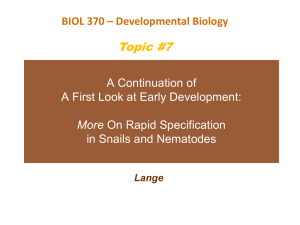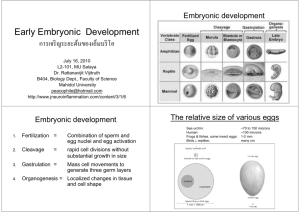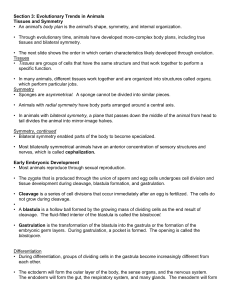Early Development
advertisement
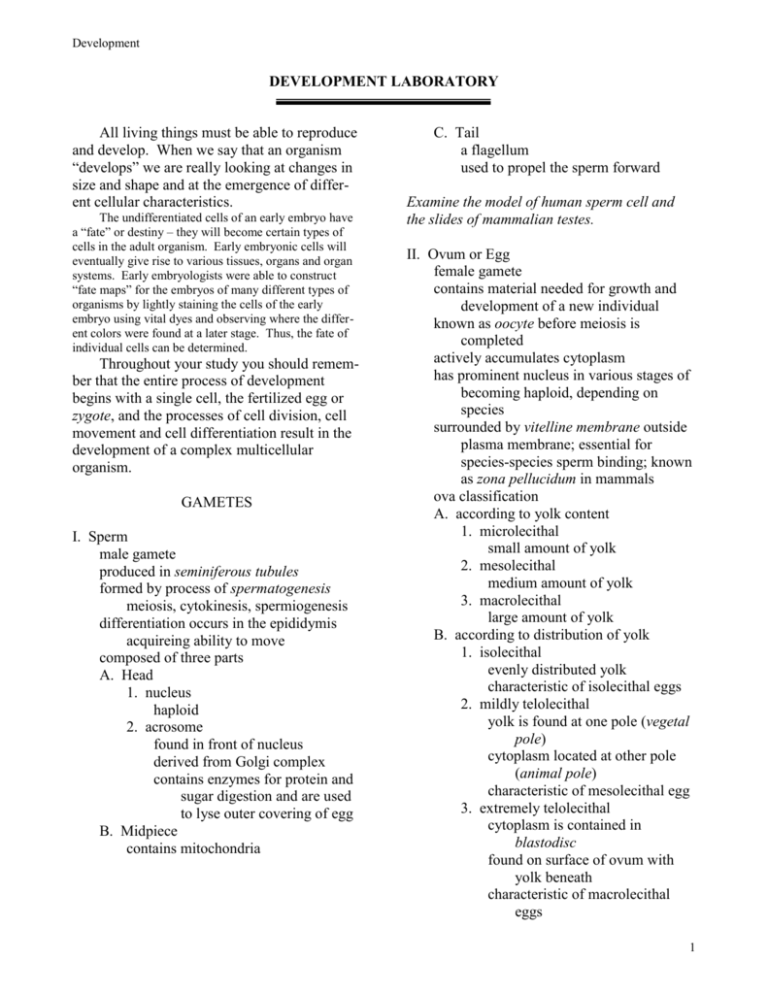
Development DEVELOPMENT LABORATORY All living things must be able to reproduce and develop. When we say that an organism “develops” we are really looking at changes in size and shape and at the emergence of different cellular characteristics. The undifferentiated cells of an early embryo have a “fate” or destiny – they will become certain types of cells in the adult organism. Early embryonic cells will eventually give rise to various tissues, organs and organ systems. Early embryologists were able to construct “fate maps” for the embryos of many different types of organisms by lightly staining the cells of the early embryo using vital dyes and observing where the different colors were found at a later stage. Thus, the fate of individual cells can be determined. Throughout your study you should remember that the entire process of development begins with a single cell, the fertilized egg or zygote, and the processes of cell division, cell movement and cell differentiation result in the development of a complex multicellular organism. GAMETES I. Sperm male gamete produced in seminiferous tubules formed by process of spermatogenesis meiosis, cytokinesis, spermiogenesis differentiation occurs in the epididymis acquireing ability to move composed of three parts A. Head 1. nucleus haploid 2. acrosome found in front of nucleus derived from Golgi complex contains enzymes for protein and sugar digestion and are used to lyse outer covering of egg B. Midpiece contains mitochondria C. Tail a flagellum used to propel the sperm forward Examine the model of human sperm cell and the slides of mammalian testes. II. Ovum or Egg female gamete contains material needed for growth and development of a new individual known as oocyte before meiosis is completed actively accumulates cytoplasm has prominent nucleus in various stages of becoming haploid, depending on species surrounded by vitelline membrane outside plasma membrane; essential for species-species sperm binding; known as zona pellucidum in mammals ova classification A. according to yolk content 1. microlecithal small amount of yolk 2. mesolecithal medium amount of yolk 3. macrolecithal large amount of yolk B. according to distribution of yolk 1. isolecithal evenly distributed yolk characteristic of isolecithal eggs 2. mildly telolecithal yolk is found at one pole (vegetal pole) cytoplasm located at other pole (animal pole) characteristic of mesolecithal egg 3. extremely telolecithal cytoplasm is contained in blastodisc found on surface of ovum with yolk beneath characteristic of macrolecithal eggs 1 Development III. Follicles part of ovary house ova mammalian follicles have several parts A. Granulose layer of cells immediately around oocyte primarily source of estradiol border antrum in larger follicles B. Theca layer cells outside of granulose source of androgens, precursors of estrogens As follicles develop, they increase in size, develop antrum, a fluid filled cavity, and produce increasing amounts of hormones; developing follicles are classified as primordial, primary, secondary, and tertiary or Graafian follicles; these latter undergo ovulation Examine the model of the frog egg, and the chicken egg on display. Examine slides of mammalian ovaries and be able to identify the parts of follicles and the oocyte. FERTILIZATION Fertilization is two events: I. Cytoplasmic Contact between egg and sperm activates egg usually prevents other sperm from entering egg II. Pronuclear Union, pronuclei from male and female open chromosomes mix these occur prior to mitotic cleavage fertilized egg is known as zygote. in frog egg gray crescent appears opposite point of sperm entry Study models of the fertilized frog egg and identify the gray crescent. The BLASTULA I. Cleavage series of mitotic divisions, often rapid transforms zygotes into multicellular a structure no gain in volume or mass each daughter cell is a blastomere. results in A. Blastula a hollow ball cavity is blastocoel OR B. Blastodisc a disc of cellular tissue formed in very yolky eggs overlies large volume of undivided yolky cytoplasm. The type of cleavage that a zygote undergoes is dependent upon (1) the amount of yolk and (2) the distribution of that yolk within the zygote: C. Holoblastic Cleavage cleavage plane cuts through the entire (= holo-) zygote divides the zygote into two large cells, first cleavage is vertical, cutting through both animal and vegetal poles second cleavage plane is at right angles to first, oriented vertically. third plane is horizontal or perpendicular to first two 1. holoblastic and equal cleavage occurs if eight nearly equal cells are formed seen microlecithal eggs blastomeres are of approximately equal size 2. holoblastic and unequal cleavage occurs when third cleavage plane is located nearer to animal pole results in top group of four blastomeres being smaller than bottom four usually seen in mesolecithal eggs blastomeres are unequal in size due to unequal distribution of yolk; animal pole cells have less yolk and are smaller; vegetal pole cells have more yolk and are larger results in a smaller blastocoel 2 Development GASTRULATION Interestingly, in the frog egg, the location of the gray crescent will determine the placement of the first cleavage division in the frog zygote. This plane will always bisect the gray crescent. The second cleavage division occurs at right angles and parallel to the first. These events are genetically programmed within the embryo and unfold following fertilization. The importance of these first two cleavage divisions which determine, first, the left and right halves of the organism and, second, the front and rear cannot be underestimated. II. Meroblastic Cleavage in macrolecithal eggs shows a spectrum of cleavage patterns because egg cytoplasm divides incomepletely (cytokinesis lags behind mitoses) some cells remain incompletely divided (incomplete cleavage) or much of the yolky mass of egg remaining undivided (discoidal cleavage). Cleavage ultimately results in an increase in the number of cells and an increase in the nuclear/cytoplasmic ratio, but does not generally lead to a change in size or shape of the developing embryo. Cleavage also divides the fertilized egg into smaller units that will be more able to regulate their own metabolism. Most importantly, however, cleavage localizes different kinds of cytoplasm in discrete cellular packages. Cleavage nuclei are thus segregated into unitary cytoplasmic environments where the interaction between nucleus and cytoplasm and between adjacent cells may result in different populations of cells becoming differenttiated. This process leads to the formation of different types of tissues with increasingly specialized functions. As these tissues and the organs they comprise develop, the embryo will also change in shape – a process called morphogenesis. Cells must move and change their positions relative to other cells. This “migration” is called gastrulation and the embryonic stage formed as a result of the process is called a gastrula. During gastrulation cells move into definitive locations and as development proceeds they become progressively more differentiated, that is, their fate becomes determined. Cells of the blastula can generally be transplanted to other locations and subsequently will assume a normal role for cells located in the new site. However, as development and differentiation continue, cellular potency is reduced and, at some point, the transplantation of eye tissue to the belly will cause an eye to develop at this site, the transplantation of a limb bud to the head will cause a limb to develop at this point, etc. Thus, cells interact with one another and development is really underway. Gastrulation is an early developmental stage in which a hollow ball or disc of cells is transformed into a tube (endoderm) within a tube (ectoderm) containing mesoderm between the inner and outer tubes. Somehow the migrating cells of the blastula must assume this arrangement. I. Amphioxus Gastrulation simple invagination of cells occurs at blastopore (opening into primitive gut or archenteron) outer cells become ectoderm inner cells become endoderm mesoderm forms from cells between ecto- and endoderm and within blastocoel; may involve some independent cell migration Study gastrulation in amphioxus using the models. Examine the cleavage stages of amphioxus and frog embryo models on display. Consider what happens to the size of the individual cells and what happens to the size of the embryo itself. Study the models of cleavage leading to the blastula stage in amphioxus and the frog. 3 Development II. Frog Gastrulation in future anterior end of blastula (above the gray crescent) cells begin to move downward from animal pole and, more slowly, from sides toward this region; results in piling up of cells and their movement inward to interior and back under dorsal surface of embryo forms crease in blastoderm known as dorsal lip of blastopore as development continues, crease moves ventrally to form a complete blastopore internal movements slow blastopore is filled with yolk-laden endoderm cells forming a yolk plug. blastodisc surface forms mid-line thickening called primitive fold and groove cells move down into blastocoel streaming anteriorly and laterally anterior end of primitive groove, primitive pit, is an active area of movement functionally equivalent to dorsal lip of blastopore in frog. B. Hypoblast blastocoel separates these layers as development continues, and with the differentiation and beginnings of organogenesis in more anterior tissues, the primitive streak moves posteriorly and is gradually obliterated. Study gastrulation in the frog models. III. Chicken Gastrulation blastula stage consists of a blastodisc which lies on top of an undivided mass of yolky cytoplasm separated from cytoplasm by subterminal space cells of disc migrate to and delaminate from upper layer to form two separate tissues A. Epiblast cells move posteriorly and medially on Examine a whole mount of the chicken embryo at 18 hours. DO NOT USE HIGH POWER ON WHOLE MOUNT SLIDES! Find the notochord; head fold, anteriorly; neural tube; primitive folds; primitive groove; primitive pit; the area pellucida (where the blastodisc is separated from the underlying yolk by the subgerminal space); and area opaca (where the blastodisc is in contact with the yolky cytoplasm). 4 Development AM AO AP HN HP NO anterior margin of mesoderm area opaca area pellucida Hensen’s node, dorsal lip head process, chordamesoderm notochord PA PF PG PP PS proamnion primitive fold, lateral lip primitive groove, blastopore primitive pit, anterior blastopore primitive streak 5


